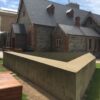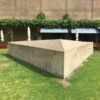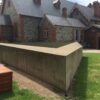Former director of the Art Gallery of South Australia, Ron Radford claimed that Untitled by American minimalist artist Donald Judd is ‘one of the finest twentieth-century sculptures in the collection but it’s also one of the most misunderstood works in the collection… In fact, most people don’t even understand that it is a work of art!’
So what is the story behind Judd and this triangular concrete structure? Judd began his artistic career in the 1950s as a painter. Over the next decade, he gravitated towards sculpture, having recognised that ‘actual space is intrinsically more powerful and specific than paint on a flat surface.’
In Arts magazine reviews during the 1950s and 1960s, Judd was an advocate of ‘new art’. He became known for arguing that painting was ‘finished’.
His sculptural works explore space and form with a variety of industrial materials, including aluminium and stainless steel. Made of reinforced concrete, the bold lines of Untitled work both within and against their physical surrounds. Judd saw strength and clarity in singular forms and preferred to focus on “the thing as a whole” rather than as a composition of its parts. For Judd, as for many artists of his generation, the physical environment is a fundamental part of his work.
This sculpture was commissioned by the Art Gallery of South Australia in May 1974. Its installation in 1975 coincided with an exhibition titled ‘Some Recent American Art’, which showcased conceptual and minimalist art from New York’s Museum of Modern Art. In the context of the Vietnam War, the exhibition and Judd’s work sparked heated public debate and protests. Both were denounced by local students and academics, the media and political groups as “American imperialism” and “servility to things foreign”.
Thirty years after its installation, Untitled continues to evoke equal measures of appreciation and contempt. A stark monument to minimalism, Untitled also continues to raise many questions about the nature, purpose and value of contemporary art.







Comments